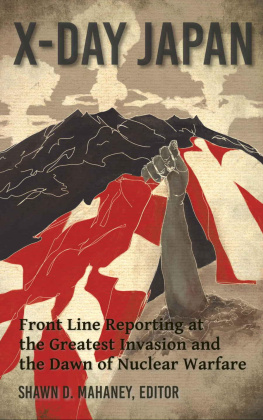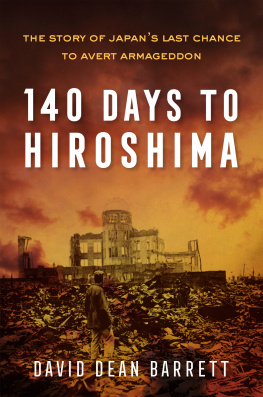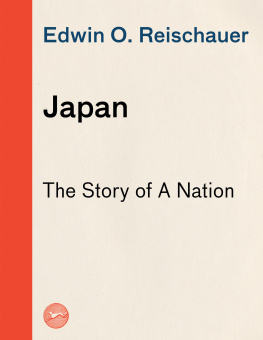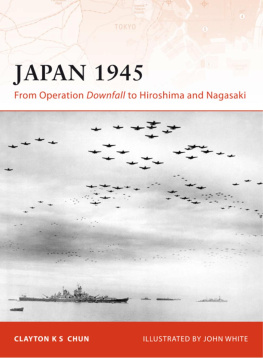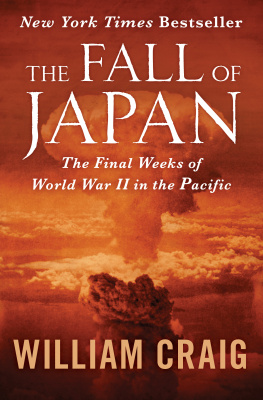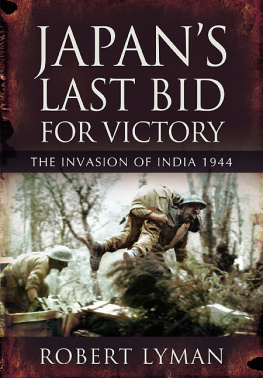THIS TEXT CONTAINS GRAPHIC DESCRIPTIONS OF VIOLENCE AND ACTS OF UNRESTRICTED WARFARE
A freely distributable sample of this entire book (not just the first portion), is available from the project web site, xdayjapan.com .
Guide for the Modern Reader
The book Kyushu Diary was originally published in 1946, in which Walter F. Tuttle combined his own columns and other notes into an edited compilation. The second edition of 1952 was also by Tuttles own hand, with added footnotes, a map, some previously censored sections, and a post-script from the author. We are not calling this new book a 3 rd edition. We have left Tuttles own 2 nd edition of his compilation intact. X-Day: Japan starts with the second edition of Kyushu Diary and expands on it with extra features for a 21st century presentation.
The target audience of Walter F. Tuttles original Kyushu Diary is a newspaper reader of 1945. That person speaks a slightly different language from someone in the 21st century. That reader was persistently exposed to an argot of military affairs during six years of global war. Some of the words and concepts novel to that reader are mundane to us now, and many common phrases or jargon of that fast-changing time quickly became anachronistic or forgotten.
Tuttle wrote that logistics was a new word to many people then, as fielding a large army into undeveloped territory across a vast ocean was an unprecedented concept. In our modern post-jet-age economy, logistics is found in perky ad slogans of major companies.
Our modern world has been shaped by things we call low intensity conflicts, limited war, and counter-terrorism operations. These are all terms that would have been completely unknowable to a reader of the pre-nuclear 1940s. To help the modern reader bridge those gaps of time and language, we have included a section of brief historical context, and a small glossary.
Histories are generally either top-down views, summarizing the whole situation, or narratives from an individual perspective. Tuttles Kyushu Diary is at its heart a personal narrative. But Tuttle went to some trouble to paint a complete picture of the scene in the Pacific, from the home front all the way across to the battlefields in Japan, for the benefit of American readers who had been shown mostly news from Europe in the preceding years. Toward that effort we add this guide, additional maps, a list of further reading, and a judicious few additions to the text footnotes. The format of any notes added in 2015 will be as here in the endnotes.
Tuttle believed in the spontaneous uncertainly of momentous events, which could turn out vastly different from changes in decision making or from natural flukes, and he was keen to communicate this to readers. In that spirit we also include a list of books of alternate histories or historical fiction novels, fantastic explorations of entirely possible what-ifs in this part of history. Popular topics in this genre are What if we forced Japanese surrender by dropping atomic bombs on cities instead of military targets? and What if we dropped atomic bombs on cities and they kept on fighting anyway?
The book is not a parade of military hardware or a treatise on combined arms tactics. It does not get into any high level politics or command decisions. As before the war, Tuttle wrote about people and how they over came their own local problems. As a reporter he provided regular updates about the progress of each battle and the larger situation, but his real interest was in setting the stage for human stories to play out.
The text of Kyushu Diary varies considerably from the columns that were published under Tuttles byline during the war. The columns were worked over by many editors, and parsed out to fill some number of column-inches three days a week. Tuttle did not actually write to a format or deadline; he submitted when he could. The book was written directly from Tuttles own notes and original submissions. Many boring days are skipped, and some busy days have a dozen pages of dense material. Thats war for you.
Editors preface, Kyushu Diary, 2nd Edition
The greatest historians remain those who tell the story as it happens, with fidelity but without theories to advance and without trying to build a story by selection and speculation. We believe that Walt Tuttles Kyushu Diary is just that sort of direct honest work history from the own eyes of the historian, which will be cited without caveat or argument for generations.
In this time of uneasy peace and containment policies, we are pleased to present the second edition of Kyushu Diary. Great armies are again poised across imaginary lines from each other, as tangled webs of ancient rivalries, incompatible cultures, territorial ambition, and new existential threats challenge the lasting peace and trust many hoped they had fought for in the preceding generation. What we have learned, mostly the hard way, about the new epoch of nuclear warfare may temper impulses to action, or drive them with desperate immediacy. Only time will tell.
History may be a never ending game of unfinished business. Only the last person left in history will have a clear view to say. For his part, Walt Tuttle has limited his post-war edits of this book to a few footnotes which highlight the unknowns of battle, some choice historical quotes to caption each chapter to remind the readers, politicians, generals, and citizens alike that very little changes in human history and a reflective postscript. Walt refused to put any preface before the journal entries, which might color perspective of the reader.
The Defense Department has let us re-submit the material through the military censors. A number of details are no longer redacted. Some paragraphs flow better, stories are more complete, and details such as the planned positions of maneuvering units are now in print.
We didnt get everything through though. The military is wary of letting loose information on tactics that may still be current. No one will say if Japanese imperialists, Chinese communists, Russian communists, or some other group will present the next military challenge, but for once the U.S. military is ready to admit in a post-war time that there will be a next challenge.
As a book, Kyushu Diary is substantially different from a simple collation of newspaper columns. Walt Tuttle went back to the original source material, his own notes and unedited submissions, and constructed the book under one structure. A close eye will catch a few themes and clever call-backs.
One of the original editors cautioned Walt that the 200 pages of conventional combat stories were, repetitive. The writing is interesting, but what it describes over and over is somehow both brutal and boring.
Walt Tuttle replied succinctly, If thats how it reads, then good. Because thats exactly how it was.
Francis Dixon, Stone Lake Press
February, 1952
Saratoga, New York
Kyushu Diary
Walter F. Tuttle
July 16, 1945 : San Diego, California
They made me a corporal today. Its completely ceremonial, of course. Civilian war correspondents do not have a rank. While normally billeted , so there was a slightly farcical ceremony in the corner of the HQ office courtyard.
Commander Samuel Sammy Adelanto, XO of the sprawling and ever growing naval base, pinned an oversize medal on my chest that one of the mess cooks had fashioned from a large can lid . A few words were said half in jest about getting me out of their hair. A couple veterans from remote islands in the central Pacific earnestly wished me luck they said I hadnt seen the worst of anything yet. Two young recruits about to deploy chatted me up, probably hoping to get their names in the paper (Marine Corps 2 nd Lieutenant Victor Saldano of east Queens, New York, and Marine Private Smithy Batson, of Knoxville, Tennessee).

